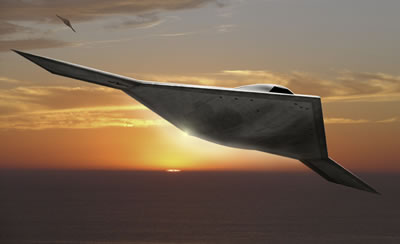Northrop Grumman (NYSE: NOC) won a $635 million US Navy contract to build a Carrier-based (CV) Unmanned Combat Air System Demonstration vehicle (UCAS-D). The program will mature critical carrier suitability technologies for future low observable unmanned combat platforms. Once proving these capabilities, the Navy is expected to launch a full scale development of a future UCAV, which could be fielded by 2018.
As a stealth aircraft, UCAS-D will complement the carrier-based version of the Joint Strike Fighter (F-35C), it will be operated by the US Navy, UCAS will become the carrier task force’s “first day of the war” asset, similar to way B-2 and F-117 are used by the US Air Force. As a refuellable unmanned platform it will provide the Navy with persistent capability over selected, high value targets in the future battlespace, providing real-time targeting data for weapons launched from other platforms, or direct attack by weapons carried on board. The unmanned combat aircraft will have the capability to acquire targets at high precision, designate fixed or moving targets, strike them with precision guided weapons and collect and disseminate post strike information.
 The US Navy UCAS program was born from the former Joint Unmanned Combat Air Systems (J-UCAS) program sponsored by DARPA. For this program Boeing developed the X-45 while Northrop Grumman developed the X-47 UCAV demonstrators. The Navy’s UCAS is focusing on a strike-fighter sized unmanned air vehicle which will demonstrate carrier flight operations. Testing is scheduled to begin by mid 2010 and culminate with carrier flight operations in 2013. The tests will involve shipboard operation, including catapult takeoffs, arrested landings and flight in the immediate vicinity of an aircraft carrier. The air vehicle will not carry weapons.
The US Navy UCAS program was born from the former Joint Unmanned Combat Air Systems (J-UCAS) program sponsored by DARPA. For this program Boeing developed the X-45 while Northrop Grumman developed the X-47 UCAV demonstrators. The Navy’s UCAS is focusing on a strike-fighter sized unmanned air vehicle which will demonstrate carrier flight operations. Testing is scheduled to begin by mid 2010 and culminate with carrier flight operations in 2013. The tests will involve shipboard operation, including catapult takeoffs, arrested landings and flight in the immediate vicinity of an aircraft carrier. The air vehicle will not carry weapons.
“This specific contract is for technology development and demonstration and will not be an operational system” explained Navy Capt. Rich Brasel, program manager for NAVAIR’s technology demonstration effort here. “But through it, we will develop knowledge, skills and technologies specific to operating an autonomous low-observable unmanned air vehicle in an aircraft carrier environment. This is a critical step in efforts to develop future Naval Aviation combat capabilities.”
Subsequently, following the successful conclusion of these trials, a full-scale development program will be launched, with a targeted service entry date in 2018.
The X-47B will be capable of operating at altitudes from sea level up to over 40,000 ft, at a combat radius of 1,500 nm (on ISR missions) flying at high subsonic cruise speed. It will be able to carry up to 4,500 lbs of payload (2,045 internally). The UCAS-D will be equipped with various sensors including electro-optical infrared (EO/IR), Synthetic Aperture Radar (SAR) with ground moving target indication (GMI) capability, electronic support measures (ESM), and others. Unmanned combat aircraft are expected to be used for intelligence, surveillance, targeting and reconnaissance (ISTAR) missions, long range precision strikes, suppression of enemy air defenses (SEAD), close air support, electronic attack, and information operations.





















